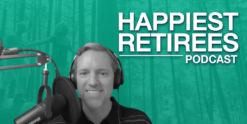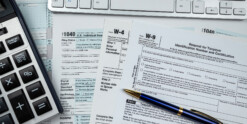Hard to believe, but we’re heading around the corner from 2017 into 2018. As the new year approaches, you’re likely considering new financial goals, like a revised budget, a better investment strategy, or even the big R – retirement.
If checking out of your career and into the post-work portion of life is on your New Year’s to-do list, it’s important to really assess where you are, both personally and financially. The absolute last thing you want to do is clock out for the last time only to find you’re not truly prepared to step away from work.
Ask yourself these five questions to see if you’re ready to retire.
1. Do you have plans for your newfound free time?
Of course, the financial aspects of retirement are critical, but so are the social aspects. The day in, day out of your retirement years deserve the same attention that your portfolio gets. After all, folks these days often spend upward of 30 years living the retired life. So, do you have a plan for how you’ll make the best of this golden time?
Based on my research and firsthand experience, happiness in retirement is largely dependent on what I’ve termed “Core Pursuits” — the activities or hobbies that occupy your time and bring you joy. The data I collected show that the happiest retirees have, on average, 3.6 core pursuits, while the unhappiest have only 1.9.
2. Would Benjamin Graham be proud of your investment allocation?
Stocks have had a lucrative nine-year run. The stock portion of your investments has probably done very well. But have you rebalanced recently so you’re not too stock heavy?
I’m a big advocate for using what I call the Benjamin Graham Rule, named after the father of value investing. Also called the 15/50 Stock Rule, it recommends that as long as you believe that you have 15 more years left on this planet, you should allocate 50 percent of your portfolio to stocks and the remaining balance in various bonds and cash.
The idea is to invest enough of your savings in stocks to provide returns and keep your purchasing power healthy over the course of a long retirement, while keeping enough in bonds to provide stability during market setbacks.
3. Will your investment portfolio pay you for the rest of your life?
There are some general guiding principles to help discern if you have the financial wherewithal to pay yourself adequately once your paychecks stop. Let’s talk about one of my favorites: the 1,000 Bucks a Month Rule.
The 1,000 Bucks a Month Rule provides that for every 1,000 bucks per month you want to have at your disposal in retirement, you need to have $240,000 saved. That’s assuming a withdrawal rate of 5 percent. Do the math, and you’ll see that $240,000 times the 5 percent rate is $12,000, and divide that by 12 months and you have your $1,000. Voilà.
Your extra $1,000 can supplement your Social Security benefits, pension, part-time work income, and any other streams of money you establish in your retirement years.
Some key points to remember are that the rule doesn’t work linearly over the years. When market and interest rates are in a normal historical range, the 5 percent withdrawal rate works well. You must, however, be willing to adjust your withdrawal rate down if market forces work against you.
The rule also doesn’t work the same at every age. A person at “normal” retirement age (65+) can plan on a 5 percent withdrawal rate from their investments. A younger retiree, say in their late 50s to early 60s, should plan on withdrawing a lower number, typically 4 percent or less. If you retire in your 50s, the time horizon is too long to start withdrawing 5 percent.
4. Do you understand how income investing works?
It’s not enough to rely on your savings to support you. You also need a retirement income plan. Here’s where income investing comes in.
To implement income investing simply, I use an approach called the “Bucket System.” Using this method, all of the money you invest will fall into one of four asset groups, or “buckets.” These buckets can work together to provide you with an investment “paycheck” to fund your spending needs.
The four buckets are Growth, Income, Alternative and Cash.
Your Growth bucket captures capital appreciation from stocks in fast-growing companies that currently provide no dividend income. But you want dividends, too, so here we also include your dividend-paying stocks — typically in the sectors of health care, utilities, telecommunications and consumer staples.
The Income bucket is invested in various types of bonds. Of course, bond types range from very safe (Treasury) to very risky (high yield), and incomes vary accordingly. Here, you’ll want to balance your bond types to maximize returns and simultaneously protect your principal.
The Alternative bucket contains any asset that isn’t a traditional stock or bond, like real estate investment trusts (REITs), master limited partnerships (MLPs), preferred stocks, and closed-end funds. These investments may generate higher current income than stocks and bonds, but you do have an accompanying higher level of risk.
The Cash bucket is an emergency fund. Ideally, you should have six months of living expenses stashed in money markets, CDs or savings.
5. How’s your health … insurance?
Health care is one of the largest retirement expenses. It can account for as much as 15 percent of spending. It definitely deserves some thought before you switch into full-time retirement mode.
If you’re retiring at 65 or older, you’ll likely rely on Medicare to meet your health care needs. If you’re leaving your job before that age, and won’t receive insurance through your former employer or your spouse’s current employer, you’ll have to go it alone. Whatever the case, you’ll want to plan ahead and have a good estimate of annual premiums, deductibles, co-pays and other out-of-pocket costs.
If you’re not yet eligible for Medicare when you retire, shop your options carefully. You can work with an insurance policy broker, like Al from Shop Benefits, to find the best deal for you. Another way to get pre-Medicare coverage: snag a part-time job that offers benefits, like one at Costco, Whole Foods or Starbucks.
If you can honestly answer these questions in the affirmative, then Happy Holidays to you! You’ve given yourself the gift of a lifetime — the ability to happily retire whenever you’re ready. If not, well, now you know where to start with your New Year’s resolutions.
The original AJC article appears here.
DISCLOSURE
This information is provided to you as a resource for informational purposes only. It is being presented without consideration of the investment objectives, risk tolerance or financial circumstances of any specific investor and might not be suitable for all investors. Past performance is not indicative of future results. Investing involves risk, including the possible loss of principal. This information is not intended to, and should not, form a primary basis for any investment decision that you may make. Always consult your own legal, tax or investment advisor before making any investment/tax/estate/financial planning considerations or decisions.













